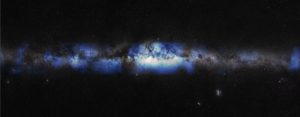
First 'ghost particle' image of Milky Way galaxy captured by scientists

From visible starlight to radio waves, the Milky Way galaxy has long been observed through the various frequencies of electromagnetic radiation it emits. Scientists have now revealed a uniquely different image of our galaxy by determining the galactic origin of thousands of neutrinos — invisible “ghost particles” which exist in great quantities but normally pass straight through Earth undetected. The neutrino-based image of the Milky Way is the first of its kind: a galactic portrait made with particles of matter rather than electromagnetic energy.
The breakthrough was achieved by a collaboration of researchers using the U.S. National Science Foundation-supported IceCube Neutrino Observatory at NSF’s Amundsen–Scott South Pole Station in Antarctica. The immense observatory detects the subtle signs of high-energy neutrinos from space by using thousands of networked sensors buried deep within a cubic kilometer of clear, pristine ice. The results were revealed at an event at Drexel University and published in the journal Science.
“I remember saying, ‘At this point in human history, we’re the first ones to see our galaxy in anything other than light,'” says Drexel University physicist Naoko Kurahashi Neilson of the moment she and two doctoral students, Steve Sclafani with Drexel and Mirco Hünnefeld with TU Dortmund University in Germany, first examined the image. Kurahashi Neilson proposed the innovative computational analysis used to generate the image and received funding to pursue her idea through a grant from NSF’s Faculty Early Career Development program.